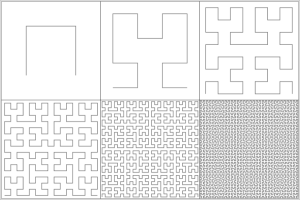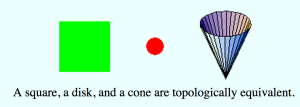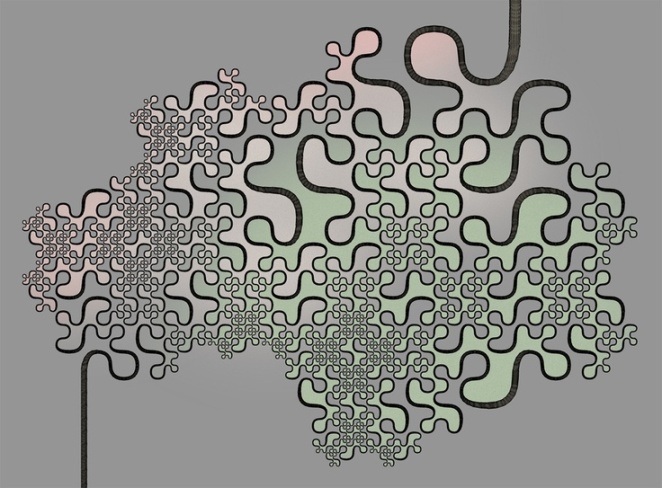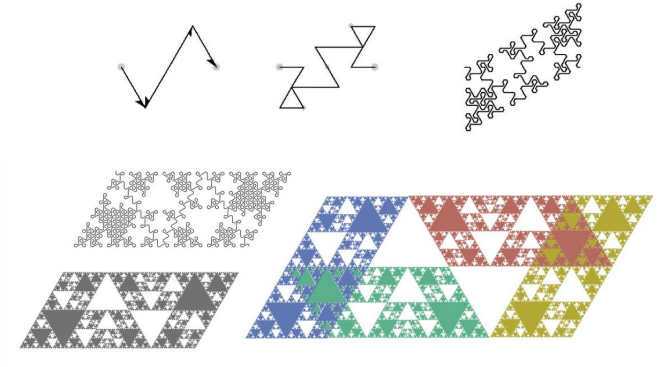 Wikipedia says:
Wikipedia says:
“In mathematical analysis, a space-filling curve is a curve whose range contains the entire 2-dimensional unit square (or more generally an n-dimensional hypercube“.
The image at right shows the Hilbert curve as an example. Indeed, the Hilbert curve fills a square. And its 3D counterpart fills a cube.
 However, a space-filling curve (or…to just stick with two dimensions: a plane-filling curve) can be more generally described as a curve that fills a region of the plane that is topologically equivalent to a square (or…a disk). Note that a filled-in square, a disk, and a cone are topologically the same. “A cone?” you may ask. Yes, it has one surface (interior), and one boundary.
However, a space-filling curve (or…to just stick with two dimensions: a plane-filling curve) can be more generally described as a curve that fills a region of the plane that is topologically equivalent to a square (or…a disk). Note that a filled-in square, a disk, and a cone are topologically the same. “A cone?” you may ask. Yes, it has one surface (interior), and one boundary.
Now consider the following space-filling curves:

Here we see the famous Dragon Curve, the Gosper Curve, and two curves that I discovered. If you have spent any time studying the Dragon curve, you know that it can be decomposed into a series of “body parts” joined at wasp-waist points. How many body parts? Why, infinitely many, to be exact. Topologically-speaking, this would be the same as an infinite chain of tangent disks.
Next is the Gosper Curve. it is topologically equivalent to a disk. Mandelbrot compared its boundary to the shape of France. Appropriate for a discussion on fractals, since the boundary of France is almost entirely determined by coastlines and mountain drainage divides.
And what about the last two curves? My first guess was that the third one from left, the “Dragon of Eve“, is topologically equivalent to a disk….however, there are regions of the boundary which get closer and closer, every time the curve is iterated. My conjecture is that the curve approaches a state of self-contact at the limit. That puts it in a different topological category than a mere disk, since the boundary is self-touching at infinitely many points.
The last curve is one I call “Brain-Filler“.

This curve resolves to a region of the plane that is topologically equivalent to a disk. Ignore the lines that extend upward and downward; they are thickened for aesthetic reasons. And besides, when iterated to the limit, the infinitely thin nature of a fractal curve gives way to the finite shape that it fills.
But!
…you may have noticed the way the curve wiggles its way through the shape. It is not evenly-filled, as in the case of the Gosper curve. So, the question comes up: does it really “fill” the space if it is not filling it evenly?
We could ask the same of Mandelbrot’s famous Snowflake Sweep.
Think through this with me: as the curve is iterated repeatedly, replacing each segment with a smaller, transformed version of itself, the interior of the snowflake curve become ever more filled-in. But…the density. varies.
At the limit, I conjecture that the interior will be filled-in with varying degrees of infinite density. And I am talking about different kinds of infinity in the Cantorian sense.
The Fractal Boundaries of Fractal Curves
So…there are space-filling curves that fill planar regions with fractal boundaries – boundaries that are more interesting and varied than boring old squares; boundaries that come around and touch themselves, or even penetrate themselves in ways that dizzy the mind.
Space-filling curves are like symphonies – beautiful on all scales.
There may be a valid reason why the authors of the Wikipedia page cited above did not include any non-square space-filling curves. But I cannot think of a good reason – other than the fact that the Hilbert Curve provides a clear, easy-to-understand, easy-to-visualize example. However, a good example should not justify an incomplete definition.
Mandelbrot spent his career trying to get geometers away from squares and circles, and to appreciate, understand, and describe the fractal geometry of nature. His amazing book still stands as the best original source for fractal geometry, in my opinion.
I eagerly await your comments!


Post your curvy space-filling curve to Wikipedia and find out what they think!
LikeLike
Reblogged this on MYYAARC.
LikeLike
So…is there a space-filling curve that will fill a Sierpinski Carpet, or a 3D-equivalent that would fill a Menger Sponge? Is it worth looking, or is it possible to prove that there is none?
LikeLike